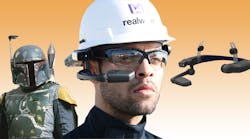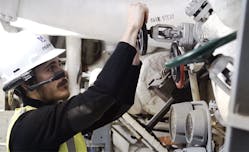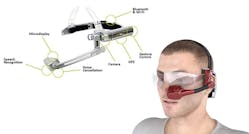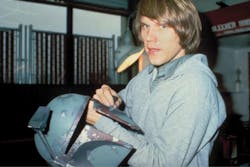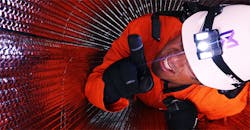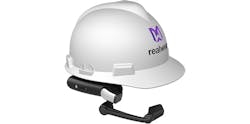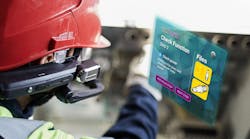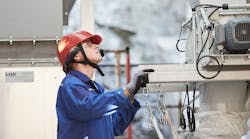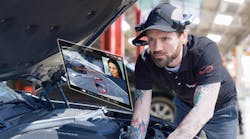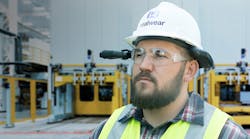RealWear’s HMT-1, short for Head-Mounted Tablet, has a monocular display to view work instructions, a camera to send POV video to a remote expert offsite, and connectivity to interact with IoT-enabled machinery. These are great features and the performance gains and error reductions that come with them are why so many companies are investing in industrial wearables. But nearly every new industrial wearable has these functions, making the big question now not if your team should invest in these newfangled face computers, because yes, you should, but rather which one is best for you.
Cost, comfort, computing power. These are all good places to start talking choices, but the HMT-1 changes the conversation completely. It’s the first completely voice-operated industrial wearable. This function generates true hands-free operation and is as paradigm-shifting as touchscreens were for cell phones.
More importantly, it has a form factor crafted for the down and dirty, and all together dangerous jobs where you’d want to full use of hands. They can be clipped onto hard hats, fit with glasses or protective eyewear, have an adjustable boom for optimal display position, and are water and dustproof. The battery lasts a full 8-hour shift, too. Because let’s face it, a tool or gadget can promise all the coolest bells and whistles a dev team can cram in, but if you can’t access them on the jobsite, they might as well not exist.
We asked RealWear’s high energy CEO Andy Lowery, former president of DAQRI and recently retired naval reserve officer, to talk up the product and tell you why your manufacturing facility should order it this July.
New Equipment Digest [NED]: So first off, why should plants invest in wearables?
Andy Lowery [AL]: We’re decades away from self-healing machines and robots maintaining our equipment or manufacturing our equipment. So long as we have humans in the loop, we need to equip these humans with the best-computerized tools to create this symbiotic relationship where computers can figure out the best tactics, the best data the best stuff when it comes to analysis and history arcs and patterns. And then have the human be the abstract thinker, the creative force. Stuff that requires complex thought, there is no computer that can outflank the strategy and the abstraction of a person. The coupling of these universes together I think creates at least for this century the most powerful combination.
NED: Is there a rule for when to use an industrial wearable?
AL: I've been studying this stuff and conducting internal and external studies for a number of years and what I found in manufacturing is that simple routine repetitive manufacturing jobs are not well suited for augmented reality. Believe it or not, they're not actually sped up or nor or any errors kind of reduced. It turns out that AR can slow down the individual.
But if you're looking at something that's highly complex and highly infrequent in the way that you build or assemble, like Boeing and their 787 lines or Huntington Ingalls Newport News Ship Building, then it makes a lot of sense. They build these great big aircraft carriers and great big submarines. These are very very complex manufacturing jobs that take years to complete. And the folks that are performing the actual activities are doing the activities once every six months or once every year or once every few years because of the frequency of the production of these large multi-billion dollar systems. So when you look at those types of manufacturing applications, the remote guidance—whether it's work instructions or even videos that you can have just shown to in a hands-free manner, then you can immediately start to apply that video instruction.
NED: So who is responsible for developing this new Head Mounted Tablet wearable category?
AL: A lot of this has been a decade in the making. Dr. Chris Parkinson, who is now my CTO, spent 10 years studying voice extraction noise cancellation and voice recognition and building that into the Kopin systems. Kopin makes component solutions for the Joint Strike Fighter pilot helmet and designed the Golden-i platform, a Kopin reference design in 2013 that was operated by voice commands.
Our industrial designer Stephen Pombo has been working in wearable computing systems since literally the early '80s. He worked with Joe Johnston on some of the concept art for the Boba Fett helmet and he went to Kopin in the late ’80s to try to actualize the art that they had created for the Boba Fett costume.
At the beginning of 2016, right after I left DAQRI, they asked me to become CEO. A lot of what we've done is like a year in the making.
NED: What’s so important about voice operation?
AL: Once you put an HMT-1 on and you start driving it with your voice, you’ll immediately say, “Oh I get it. I get what has been holding back wearable computing for the last five years.” And that thing is a user interface that is easy to use and consistently reliable. When you put on our system, even in noisy environments up to 95 to 100-decibel environments, just works. It works 95 to 98% of the time on the first pass. You’ll have to repeat yourself 1 out of every 25 times.
And you’ve got to nail a voice-driven user interface and that's the extremely important thing that RealWear does better than anybody else.
NED: What other features should we know about?
AL: The defining characteristic starts with on the physical side the ability to affix it either to a hard helmet, a bump cap baseball cap or the head with a series of straps and comfort features we use. By wearing it on the head, you distribute the weight and so you don't have to limit yourself to 100 grams or less in order to have comfortability to wear it for a full day or for shift very comfortable. That extra 200 grams allows us to have an 8-core processor and a 3,300 milliamp per hour battery and all these other different very rugged industry focus type of physical characteristics. It's IP66, so it’s waterproof and completely dustproof. And we do a full 2-meter drop test on every single system to concrete.
The HMT-1 has two USB ports. We took a FLIR ONE camera and attached it with a piece of Velcro to the head of the hard helmet and instantly had a sensor to send thermal imagery to the display.
We are an extremely open platform both from a hardware and a software point of view. And we are absolutely laser-focused on compatibility with existing PPE. We have a partnership with MSA, the largest hard helmet maker in the world.
NED: Besides voice recognition, what sets this apart from other wearable options?
AL: One of the most critical things obviously with a heads-up display is the occlusion of natural vision. It's this idea of augmented reality leaning into virtual reality space and you become kind of engrossed with the actual digital information and not paying attention to the space you’re working in. That’s a very unsafe modality for these hazardous situations. our system purposely is built to be a dashboard, and why we have that boom arm that extends your tablet screen out in front of your eye. You have a lot of freedom to move it completely out of your way, so you don't even see the screen at all but still have the voice and the localization type information. You can position the actual display down below your line of sight, so you're looking down at it like a dashboard of your car.
NED: What’s the cost?
AL: For small quantity numbers, the suggested price is around $1,500. For larger-scale orders, the price point is around $1,000.
NED: So who has tested it so far?
AL: General Electric got one at the beginning of March, and they've subsequently placed an order for 40 more units and they're conducting pilots in 14 different business units across GE and across the globe. So we’re already getting a lot of great validation from the market and the proof in the pudding will be if we get thousands of thousands of devices shipped. That will even be more validation of it.
NED: What’s the latest development?
AL: We also offer software-as-a-service companies applets like our document navigator which allows them to embed this library into their own applications in order to provide enhanced functionality.
For example, one of our partners is HP and their HPE My Room VRG, or visual remote guidance. It's a full application installed on handheld or wearable devices. They've been using this application within their printer division and what they've found is the time to diagnose problems and solutions to problems and convey that information has been reduced by an astronomical 80 or 85% versus using just a phone call alone. They've saved millions of dollars, and they realized this works best when you have your hands free and you can walk through the printer troubleshooting procedures while someone is guiding the technicians through those same procedures, so that's why we make such a compelling partner for them.
NED: Where do you see yourself in the market?
AL: I can't see a company that we're more aligned to than Compaq. In 1982, they looked at the PC market and to compete with IBM, realized they needed to do two things really, really well. First, have an ultra-scalable product that doesn't require a lot of ecosystem development and start the whole process of software development over again from ground zero. And then the second thing they needed to change some aspect of the current design to make it more compelling. So they made a 100% IBM-compatible computer, and they made it mobile. It was the first mobile PC ever created and Compaq was the fastest company in history to do over $1 billion in revenue.
And if you look at the 2017 model of that, I believe RealWear could not fit that exact same historical model better. Our device is extremely scalable and converts any off-the-shelf Android tablet application by pulling it into RealWear Explorer to make it completely voice-driven. And we’ve fundamentally changed the tablet by making it wearable on a hard hat or head and voice-driven verse hand-controlled your two hands can be free to perform activities or keep yourself stable at heights or whatever it needs to be versus having to fumble and shuffle with something.
- Integrated 91dB speaker and 3.5 mm audio jack for use with hearing protection
- Clips on to hard hats. Works with safety glasses and goggles. Weighs 370 g
- Boom arm adjusts six ways to accommodate any head size or eye relief
- 16MP, autofocus, and image stabilized for hi-resolution photo capture
- Android 6.0 Qualcomm Snapdragon 625 platform with 2GB RAM/16GB Flash
- GPS, gyroscopes, and digital compass for positioning
NED: So who is your IBM?
AL: There’s somewhere around 500,000 to 1 million ruggedized tablets shipped each year to industry, like the Panasonic Toughpad. That's the true competitive market that I'm aiming for. Not these other wearable companies that have monocular devices and solutions like Google Glass and Intel Jet Recon Pro.
I encourage them to continue to kind of put forth great products and try to get their own applications built in their own ecosystems because they can increase the size of the pie. One of the roadblocks you find in any sort of industrial tool is that the initial uptake is slow.
But with handheld tablets, workers don’t know where to put them. So they're sticking them on pipes or valves or propping them up by the other pieces of machinery so they can have a stable screen. Then they're clicking on the buttons and then they're going back to do the work.
We delivered some HMT-1’s to a defense contractor who builds submarines, and these folks have a very high bar for quality. The feedback was that this was the first electronic tool they could actually use.
NED: And you were in the Navy’s surface nuclear program. Were the memories of navigating all those 30-lb. tech manuals the inspiration for your work instruction feature?
AL: Admiral Hyman G. Rickover, who established the Navy nuclear power program, didn't trust computers. He said computers weaken the mind and basically distance the knowledge of the actual folks that were running the reactors from the actual how the stuff actually worked. In the early ’90s, we still did most of our calculations and stuff like estimated critical positions very manually.
It was frustrating and discombobulating having to jury rig all these things together in order to perform the work. It was just very arduous and although maybe I couldn't have thought of what could be better at that time, I can clearly see now that this is the tool I needed.










